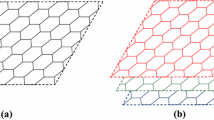Abstract
Strain rate effects on the mechanical properties of graphene sheets (GSs) contain randomly distributed defects investigated by molecular dynamics simulations, and the results have been discussed. The strain rate has a significant effect on the tensile strength, while fracture strain and failure mechanism of GSs and elastic modulus are insensitive to the strain rate. At room temperature of 300 K, GSs without defects show that brittle failure is at a low strain rate and linear hardening is at a high strain rate. The strain rate is higher, the GSs are harder. However, GSs with a large number of randomly distributed defects only show brittle failure under high temperature. The tensile strength and fracture strain increase with the strain rate increasing. The tensile strength of GSs without defects has a linear relation to the logarithm of the strain rate, but the GSs with defects do not exhibit this phenomenon because the defects are sensitive to the strain rate. The present study provides a theoretical optimization method for the preparation and performance of GSs.













Similar content being viewed by others
References
Ansari R, Ajori S, Motevalli B (2012) Mechanical properties of defective single-layered graphene sheets via molecular dynamics simulation. Superlattices Microstruct 51(2):274–289
Banhart F, Kotakoski J, Krasheninnikov AV (2010) Structural defects in graphene. ACS Nano 5(1):26–41
Chen MQ, Quek SS, Sha ZD et al (2015) Effects of grain size, temperature and strain rate on the mechanical properties of polycrystalline graphene—a molecular dynamics study. Carbon 85:135–146
Dewapriya MAN, Rajapakse RKND, Phani AS (2014) Atomistic and continuum modelling of temperature-dependent fracture of graphene. Int J Fract 187(2):199–212
Heersche HB, Jarillo-Herrero P, Oostinga JB, Vandersypen LMK, Morpurgo AF (2007) Bipolar supercurrent in graphene. Nature 446(7131):56–59
Jung GS, Yeo J, Tian ZT, Qin Z, Buehler MJ (2017) Unusually low and density-insensitive thermal conductivity of three-dimensional gyroid graphene. Nanoscale 9(36):13477–13484
Kuang Y, Lindsay L, Huang B (2015) Unusual enhancement in intrinsic thermal conductivity of multi layer graphene by tensile strains. Nano Lett 15(9):6121–6127
Lee C, Wei X, Kysar JW, Hone J (2008) Measurement of the elastic properties and intrinsic strength of monolayer graphene. Science 321(5887):385–388
Levin DD, Bobrinetskiy II, Emelianov AV, Nevolin VK, Romashkin AV, Petuhov VA (2016) Surface functionalization of single-layer and multilayer graphene upon ultraviolet irradiation. Semiconductors 50(13):1738–1743
Liang Y, Han Q, Huan S (2015) The effects of temperature and vacancies on the elastic modulus and strength of graphene sheet. J Therm Stresses 38(8):926–933
Miao T, Yeom S, Wang P, Standley B, Bockrath M (2014) Graphene nanoelectromechanical systems as stochastic-frequency oscillators. Nano Lett 14(6):2982–2987
Mortazavi B, Ahzi S (2013) Thermal conductivity and tensile response of defective graphene: a molecular dynamics study. Carbon 63:460–470
Neek-Amal M, Peeters FM (2010) Defected graphene nanoribbons under axial compression. Appl Phys Lett 97(15):153118
Novoselov KS, Geim AK, Morozov SV, Jiang D, Zhang Y, Dubonos SV, Grigorieva IV, Firsov AA (2004) Electric field effect in atomically thin carbon films. Science 306(5696):666–669
Sadeghi Nik A, Bahari A, Ebadi AG, Ghasemi-Hamzekolaee A (2010) The role of nano particles (Si) in gate dielectric. Indian J Sci Technol 3(6):634–636
Schmiedova V, Pospisil J, Kovalenko A, Ashcheulov P, Fekete L, Cubon T, Kotrusz P, Zmeskal O, Weiter M (2017) Physical properties investigation of reduced graphene oxide thin films prepared by material inkjet printing. J Nanomater 2017:3501903
Singh D, Kumar A, Kumar D (2017) Adsorption of small gas molecules on pure and Al-doped graphene sheet: a quantum mechanical study. Bull Mater Sci 40(6):1263–1271
Song J, Medhekar NV (2013) Thermal transport in lattice-constrained 2D hybrid graphene heterostructures. J Phys Condens Matter 25(44):445007
Stuart SJ, Tutein AB, Harrison JA (2000) A reactive potential for hydrocarbons with intermolecular interactions. J Chem Phys 112(14):6472–6486
Sun YJ, Huang YH, Ma F, Ma DY, Hu TW, Xu KW (2014) Molecular dynamics simulation on double-elastic deformation of zigzag graphene nanoribbons at low temperature. Mater Sci Eng B Adv Funct Solid State Mater 180:1–6
Tserpes KI (2012) Strength of graphenes containing randomly dispersed vacancies. Acta Mech 223(4):669–678
Wang MC, Yan C, Ma L, Hu N, Chen MW (2012a) Effect of defects on fracture strength of graphene sheets. Comput Mater Sci 54:236–239
Wang L, Chen Z, Dean CR, Taniguchi T, Watanabe K, Brus LE, Hone J (2012b) Negligible environmental sensitivity of graphene in a hexagonal boron nitride/graphene/h-BN sandwich structure. ACS Nano 6(10):9314–9319
Wang X, Huang T, Lu S (2013) High performance of the thermal transport in graphene supported on hexagonal boron nitride. Appl Phys Express 6(7):075202
Zandiatashbar A, Lee G-H, An SJ, Lee S, Mathew N, Terrones M, Hayashi T, Picu CR, Hone J, Koratkar N (2014) Effect of defects on the intrinsic strength and stiffness of graphene. Nat Commun 5:3186
Zhang G, Zhang Y-W (2015) Strain effects on thermoelectric properties of two-dimensional materials. Mech Mater 91:382–398
Zhao H, Aluru NR (2010) Temperature and strain-rate dependent fracture strength of graphene. J Appl Phys 108(6):064321
Zhao H, Min K, Aluru NR (2009) Size and chirality dependent elastic properties of graphene nanoribbons under uniaxial tension. Nano Lett 9(8):3012–3015
Zhou H, Zhu J, Liu Z, Yan Z, Fan X, Lin J, Wang G, Yan Q, Yu T, Ajayan PM, Tour JM (2014) High thermal conductivity of suspended few-layer hexagonal boron nitride sheets. Nano Res 7(8):1232–1240
Zhu T, Ertekin E (2014) Phonon transport on two-dimensional graphene/boron nitride superlattices. Phys Rev B 90(19):195209
Acknowledgements
The authors wish to acknowledge the support from the National Natural Science Foundation of China (Grant No. 11702067), Guangdong Province (Grant No. 2016A030313617), and the Foundation for Young Talents in Higher Education of Guangdong (Grant No. 2015KQNCX122).
Author information
Authors and Affiliations
Corresponding author
Rights and permissions
About this article
Cite this article
Liang, Y., Huan, S. Research on Strain Rate Effect of the Mechanical Properties of Graphene Sheet Containing Randomly Distributed Defects. Iran J Sci Technol Trans Civ Eng 44, 1171–1177 (2020). https://doi.org/10.1007/s40996-019-00309-4
Received:
Accepted:
Published:
Issue Date:
DOI: https://doi.org/10.1007/s40996-019-00309-4




